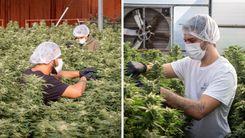Cannabis and Soil: The Role of the Plant in Environmental Regeneration and Sustainable Development
Researcher from UFJF reveals the potential of cannabis in soil recovery and reinforces the debate on its regulation in Brazil
Published on 07/11/2025

Geraldo César Rocha, professor of the Department of Geosciences at the Federal University of Juiz de Fora (UFJF) launches book Cannabis and Soil: An Introduction. Image: Canva Pro
“Cannabis has been used for millennia by humanity, whether for industrial, medical, religious, or hedonistic applications. Despite this versatility, the plant still remains ambiguous regarding its botanical classification and chemistry," states the professor of the Department of Geosciences at the Federal University of Juiz de Fora (UFJF), Geraldo César Rocha, in his latest book, Cannabis and Soil: An Introduction.
Published by CRV Publishing, the work presents a new perspective: the importance of cannabis for soil regeneration and restoration. The topic, still little explored by Brazilian academics, arrives at an opportune moment to deepen the debate on the decriminalization of the plant and the regulation of its cultivation.
In this context, the book explores, in an introductory manner, the various agronomic and environmental functions of cannabis, such as: phytoremediator of soil by absorbing heavy metals and organic compounds; restorer of degraded areas by combating erosion, decompacting soil, and recovering its organic matter; capturing carbon and acting as a biopesticide; as well as being an important agent for biodiversity and soil nutrient replenishment.
Industrial Hemp: A Tool for Soil Regeneration

A concrete example of the plant's regenerative potential was addressed in an interview with the Sechat portal in July 2024, when agronomist and president of the Latin American Industrial Hemp Association (LAIHA), Lorenzo Rolim, reinforced the potential of hemp. “Hemp assists in absorbing heavy metals from the soil — which may have leaked during floods,” explained Rolim, highlighting the plant's regenerative properties, capable of removing lead, arsenic, zinc, cadmium, among others.
Moreover, thanks to its deep root system, hemp contributes to the structuring of the terrain, removing accumulated water from the deeper layers of the soil.
Paths to Cannabis Regulation
The environmental relevance of cannabis is not restricted to the South American continent. In 2024, Portugal proposed the use of hemp to treat contamination by chemical residues at Praia da Vitória, in the Azores, a site impacted by heavy metals over decades. “It's time to embrace cannabis as an ally in environmental recovery and sustainable development in Portugal,” defended Graça Castanho, president of the International Brotherhood of Cannabis in Portugal.
In Brazil, the topic is in its infancy, with recent advances. In 2024, the Supreme Federal Court (STF) decided to decriminalize the possession of marijuana for personal use. “It's high time for Brazil to debate this plant without stigmas and prejudices, which is only seen as marijuana, and not as an important agricultural commodity that can generate income and jobs in a backward country like ours,” criticizes Geraldo César Rocha.
With this backdrop, the country is preparing for new steps. The Superior Court of Justice (STJ) stipulated September 30, 2025, as the deadline for the full implementation of the Action Plan guidelines aimed at regulating the cultivation and production of cannabis for medicinal purposes.








